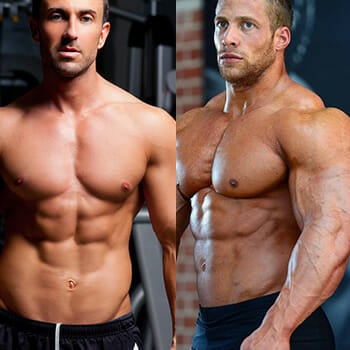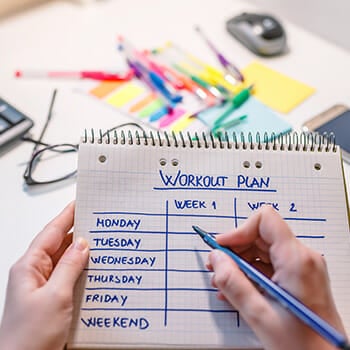A lot of people can't differentiate between lean and bulky muscles. Well, lean muscles are all about gaining muscles the healthy way. Getting lean muscles is a combination of both workout routines and eating healthy meals.
Attaining lean muscles isn't as complicated as most people perceive. It all starts with setting reasonable goals. Always start low and progressively increase your targets. As a fitness instructor, I encourage individuals to be consistent. Consistency is the key to achieving your goals.
And our team of personal trainers has put together this guide to explain how to achieve such goals.
Quick Summary
- To build lean muscle effectively, it's essential to combine a well-planned workout routine with a balanced diet rich in essential nutrients.
- Setting realistic goals and maintaining consistency in both nutrition and exercise are crucial for achieving lean muscle growth.
- The author emphasizes that achieving weight and muscle goals is approximately 70% diet and 30% strength training, highlighting the importance of nutrition in muscle building.
- The author suggests that avoiding common mistakes like neglecting rest, focusing excessively on one body part, and over-reliance on supplements is vital for successful lean muscle development.
Setting The Right Goals And Expectations
How quickly you can get to your goals, all depends on how much you change your diet and how often you train.
But, the first thing to do is to set your goal.
Lean Muscle Vs. Bulky Muscle

Yup, there’s a difference.
Lean muscle is going to give you a healthy appearance with very well-defined muscles. Basically, you’ll be able to see that there is something underneath your skin.
It’s what most people look for and is the easier goal to achieve.
Bulky muscle is what you see on bodybuilders where they aim to create as much lean mass as possible. These are the kind of guys that will block a doorway
Setting An Achievable Timeline

So, if you want to look leaner with some defined muscles that will make some heads turn at the beach, then your timeline should realistically be 6 to 12 months.
This would be based on sticking to a healthy diet and going to the gym at least 4 times a week for structured training.
If you want to bulk up bodybuilder-style, then you’re probably looking at closer to 12 months.
In my experience as a personal trainer, I have seen people do it in 6 months, but this was achieved by weight training twice a day with no more than one rest day per week.
OK, so go ahead and write down your goal and timeline, and we’ll start with what you need to achieve it.
What Does Your Body Need To Build Lean Muscle Mass
Most of my clients are surprised when I start by focusing on what they eat when we come up with a plan of how to build muscle.
But the truth is that your weight and muscle goals are 70% diet and only 30% strength training.
Vital Nutrients

To gain lean mass, you will have to get your nutrition intake to the optimum balance.
That means getting the right mix of carbs, protein, and fat while making sure you take in enough calories. In my experience as a personal trainer, protein is one of the most important nutrients, and this is backed by studies from the School of Health Sciences, Eastern Michigan University [1].
You will also need to make sure you get more than the minimum need for vitamins and minerals, which your muscles will depend on both directly and indirectly.
Training

Yes, you will have to work hard, and you’ll be lifting weights that you think don’t seem realistic. The number of reps will be reduced, but you’ll feel the burn a lot sooner than ever before.
If you do it right, then within a few days you should be feeling pain in places you didn’t know existed, but this will all be a positive sign that your body is starting to increase muscle production.
So, before you get all excited about the training program, let’s take a closer look at nutrition.
How To Structure Your Diet For Muscle Gain
OK, first things first. Those sneaky trips to Cinnabon and McDonalds have to be a thing of the past. The same is the case for the odd beer or glass of wine, and you want to make sure that you get rid of any sugary treats as well.
But what I really want to focus on is the macro nutrition details that most people completely overlook.
With the simple help of our macro calculator, you can get all the information you need for better diet planning. It will break down calories from fats, proteins, and carbohydrates, to help you identify which types of food to avoid.
You Need More Calories

The first thing you need to do is use a maintenance calorie calculator.
Based on your age, gender, weight, height, and activity level, it will tell you with reasonable accuracy how many calories you need to maintain your current weight.
Once you know this value, then add 300 calories to it every day. You will need this in order to gain weight in the form of new muscle tissue.
Anything at maintenance level or below will lead to weight loss, which is not what you want.
For serious bodybuilding goals with strength training twice a day, you will easily need to double that to 600 extra calories on a daily basis.
Essentially, exercise like weight training is only half of the question when it comes to building lean muscle mass. If you are trying to gain or build muscle mass your body needs to be in an energy surplus, so you may need to eat more -- at the correct times.
- Juliette SteenAssociate Editor
It’s All About Protein

To give your muscles all the amino acids they need to build new fibers, you’ll need to take in between 0.8 and 1 gram of protein per pound of body weight.
On very intense days you can increase that a bit more.
Most of this should come through the food you eat, but realistically you’ll also rely on supplements (more on this shortly).
Avoid Macro Balance Mistakes

Some people work on a strict nutrition percentage range for carbs, protein, and fat. I tend to take a slightly different approach.
First, I work out what the protein intake needs to be based on 1 gram per pound of body weight.
For example, if you weigh 180 pounds, then you would need 180 grams of protein. Each gram contains about 4 calories, so you’d have roughly 800 calories from protein.
Then, I work with 25% of calories coming from fat, which for the average male would work out as 2,300 calories x 25% = roughly 600 calories.
We’ve accounted for 1,400 calories, so the remaining 900 calories would need to come from healthy carbs.
Take Advantage Of Supplements
You'll quickly discover that you can reap the full benefits of intense workouts only if you maintain a healthy eating regimen and incorporate pre-workout supplements to enhance your strength.
It can quickly happen that you struggle to eat enough calories, and you won’t exactly feel like a raw egg shake with some chicken breast after a trip to the gym.
So, make sure you look at taking some mass gainers, as well as pre and post-workout protein shakes. They will really make your life so much easier. Take time to read How to properly use mass gainers to know more.
You can also check out our best supplement stack article, which is entirely based on my experience as a personal trainer.
Training Tips For More Effective Muscle Building
OK, now we get into the fun part with some tips on how to make your training more effective so that you develop muscle faster.
Limit Cardio To Warm-Ups

I see it all too often that people come to me with the perfect diet plan, and then they show me their training log. And it’s usually covered in cardio sessions.
When it comes to bulking or lean muscle gain ambition, cardio is actually your enemy. It will take up loads of time, make you feel tired and will have practically no impact on building lean muscle.
While it can be helpful during a cyclical cutting phase to lose fat reserves, you should definitely limit it to a 5 to 10-minute warm-up phase.
If you're training to gain muscle, you will need to do less cardio training. Too much cardio can actually hamper your muscle gain by slowing recovery and burning up calories that your body needs for the process of building muscle.
- Nick NilssonPersonal Trainer
When You Lift, Make Sure It’s Heavy

Now, the big question is: What’s heavy?
For some people, a 20-pound dumbbell is already extreme, while for a bodybuilder it will just about work for a warm-up exercise.
The way you can tell if you’re lvifting at your limits is that you should plan for a maximum of 8 reps in a set, and during the last 3, you have to be fighting the burn.
But that’s only your starting point.
From here, you want to start working on progressive overload, which basically means gradually adding more weights so that you’re really struggling with that last rep.
My personal experience with this approach is excellent, and there are studies by the Laboratory for Physical Activity and Exercise Intervention Research, University of Michigan, to back this up [2].
Compound Vs. Isolation Exercises

I’m going to be a bit controversial here and recommend that you stay away from isolation exercises altogether.
These are moves that target one or two muscles at most, and they are very effective if you have an area that has fallen behind.
Instead, focus on compound exercises that target entire muscle groups.
The result of this is that you put strain on more muscles in one training session, which increases the amount of testosterone and growth hormone production.
Introduce Isotonic and Isometric Exercises

Let me give you a quick explanation of what these terms mean.
Isotonic muscle contractions exert force by changing the length of a muscle.
Think push-ups, crunches, squats, and even biceps curls.
Isometric muscle contractions generate force by maintaining the same muscle length.
For example, the plank, wall sits, warrior pose, and the glute bridge.
You will get much better results by introducing both types of exercises into a gym session, as it will further trigger different types of muscle strain. The result is that your body will signal an increase in muscle creation.
Read More: Effective Psoas Muscle Exercises
Regularly Change Your Sets

One reason for doing this is that you won’t run the risk of getting bored with the same exercises all the time.
But more important than that is the fact that your muscles will become used to the same type of strain, resulting in a plateau effect [3].
Instead, switch things around a bit. Change the days around and even swap out moves and exercises.
And very importantly, if you have one specific area of your body that needs to catch up a bit, then you’ll need to work on it twice a week, not just once.
Avoid Some Common Mistakes

Now, I want to draw your attention to some very common mistakes that I see people make. I would not be doing you any favors by leaving these out of this how to get lean muscle guide.
Not Getting Enough Rest
In order to build lean muscle tissue, your body has to rest, and your muscles need to be given a chance to relax and repair. And the best time for this is while you sleep.
Aim to get 7 to 8 hours of good and continuous sleep every night, and you will feel the difference the next morning.
Focusing Too Much On One Body Part

Yes, if you pay a lot of attention to your arms and shoulders, they will build lean muscle faster. But only for a while.
The muscles will become used to the same level of strain, and you can hit a plateau.
Also, such a program can end up with you looking rather out of proportion.
I’ve seen plenty of “bodybuilders” who look like lollipops because their leg muscles are underdeveloped.
Becoming Too Reliant On Supplements
Yes, your body will need a lot of nutrients, and some of those will need to come from supplements. But the best way to source your nutritional needs is through a balanced diet.
It’s a far more effective way to boost lean muscle growth, as well as being a lot more natural and healthy.
Fasting Too Much

A regular short fast period is by no means a bad idea.
It will certainly help you lose fat to make your muscles more defined.
But, in my own experience, when you constantly fast and your weekly calorie intake doesn’t add up to a surplus, then you’ll quickly start losing weight.
Not Drinking Enough Water
No, not just at the gym while you’re working out, although that’s probably one of the most important times.
But you also have to make sure that you drink more during your recovery hours, as your increased metabolism and muscle-building process will require a lot of water.
Avoid Junk Food And Keep a Journal
The first thing I ask my new clients to provide me with is their diet and workout journal. No rewards for guessing how many actually have one.
The only way you can monitor and assess your progress and tweak your diet and strength training is by keeping detailed notes of what you eat and how much you are lifting.
When you compare those notes to your weight gain, muscle growth, and BMI, you’ll have a much clearer picture of what’s working.
Related Articles:
FAQ

How long does it take to build lean muscle?
It takes about 1 month to build about 1 to 2 pounds of lean muscle. This is based on the average person with a stringent diet and exercise routine at least 4 to 5 days per week.
How many reps should I do to build lean muscle?
You should aim to do about 8 reps per set to build lean muscle. The last three of those reps should cause a serious muscle burn that you’ll have to push through.
How much protein do I need to build lean muscle?
You need about 1 gram of protein per pound of body weight to build lean muscle. Most of this nutrition should come from your food, but supplements are great, especially after exercising.
Do high reps build lean muscle?
No, high reps don’t generally build lean muscle, because it results in a more cardio like effect. Keep the reps down and make sure you feel your muscles burning on each set to get the full benefits.
How much should I lift to get toned?
You should lift as much weight as needed to make your muscles burn in order to get toned. That pain that you feel in your muscles will signal to your body that more muscle tissue is needed.
Do you need heavy weights to build muscle?
Yes, you do need to lift heavy weights to build muscle, but heavy is relative to your current build. As long as you have to push through the burn with the chosen weight, you’ll be on the right track.
Sources:
- https://www.ncbi.nlm.nih.gov/pmc/articles/PMC6566799/
- https://www.ncbi.nlm.nih.gov/pmc/articles/PMC4215195/
- https://pubmed.ncbi.nlm.nih.gov/35438660
About The Author
You May Also Like







Muscles can be developed even without expensive equipments or getting a gym membership. The specially planned body weight workouts put enough resistance to the muscles to promote muscle growth and these no equipment workouts help in bulking up without using a single weight. But the key is to do the right exercises in quick progression that forces the muscles to be explosive. Body weight exercises constantly test your strength against gravity while pushing up the stamina of various muscle groups at the same time.
Been searching the whole internet on how to build lean muscle because it’s been 3 months since I’ve been working out and nothing happens. Guess I have to change my workout routine and diet plan to focus more on muscle growth